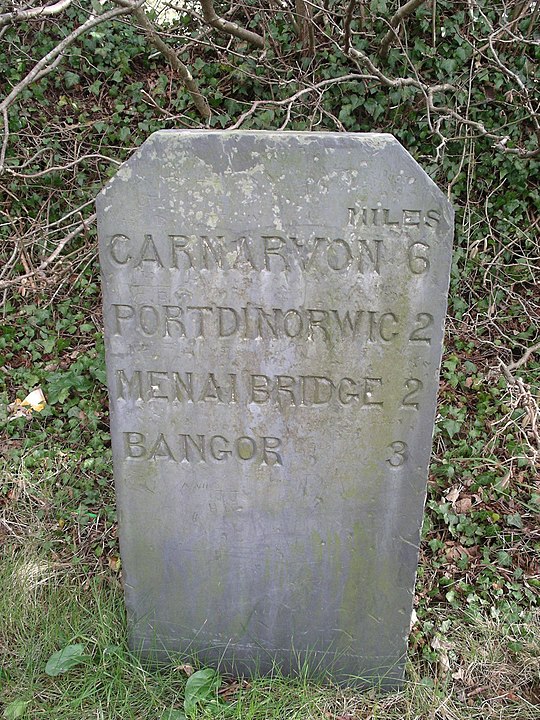
I learned this today. The mile we use today originated with the Roman mile which was one thousand paces. The word “mile” comes from “mille passus”, which means 1,000 paces.
Ancient measuring systems all began by using body parts to measure things. The oldest unit of length is the Egyptian cubit, although they didn’t call it the “cubit”. They called it meh niswt. The word “cubit” comes from the Latin “cubitum”, which means “elbow”. A cubit was the length from the elbow to the tip of the middle finger. The cubit was divided into seven palms and a palm was divided into four fingers. The fingers were also subdivided. It was first used in about 3000 BC. The problem with a system like this is that different people have different length arms, palms, and fingers. Cubit rods have been found dating from about 1500 BC, so it was standardized before then.
Many cultures also used their feet as a unit of measurement. It is theorized that people in Egypt, India, and Mesopotamia used the cubit and people in Rome, Greece, and China used the foot. The Greek foot varied in size from city to city, but the Roman foot was standardized at 11.6 inches. They divided this length up into twelfths, called “uncia”, which is where the English word “inch” comes from. When the Roman Empire fell, people continued using these “feet” and “inches”. The Charlieu Abbey built in 9th century France was built using the Roman foot as a measurement.
The idea of the mile began with Roman legionaries. It was measured as a thousand double paces. One pace was from the left foot hitting the ground back to the left foot hitting the ground again. However, like all measurement systems, the problem was that different people have different sized paces and well-fed legionaries would march longer miles than tired legionaries. To fix this, in 29 BC, the length of the Roman mile and Roman foot was standardized by the Emperor Agrippa. A pace was considered to be the length of five feet, so a Roman mile was 5,000 Roman feet.
The Romans carried this measurement of distance through their empire and people grew used to using it. When their empire fell in 395 AD and Romans withdrew, the measurement stayed.
In England, the mile continued to be 5,000 feet up until 1593. The problem was that different unit of lengths were being used at the same time and they didn’t always match up. The system of furlongs was more common. “Furlong” comes from the old English words for “furrow” and “long”. It was the length that a team of oxen could pull a plough without resting. How long they could make the furrow. Again, different oxen can pull a plough for different distances, so the length was standardized as 40 rods. A rod was originally called a perch and comes from the Roman length “pertica”.
In 1593, Parliament in England passed a law to change the length of the mile from 5,000 feet. More people were using furlongs, so they wanted the mile to be calculated in furlongs and they decided that a mile would now be 8 furlongs long. They decreed that a mile will be eight furlongs, a furlong will be forty poles, and a pole will be sixteen and a half feet. That meant that a mile was now 5,280 feet, which it has been ever since. For at least a hundred years after this law, people were producing maps with different scales on them.
All of this sounds very confusing to us, but people didn’t travel very far or fast, so there was no real need to know exact distances. 100 miles to somewhere wouldn’t be as useful as 3 days walk to somewhere. Length measurements were mostly used for land, the sale of land, and the taxation of land. It was only really with the introduction of the railway that distances became necessary for regular people.
The metric system invented in France in 1795 seems to make a lot more sense than the imperial system, but there is a lot of history and pride tied up in the imperial system. People in England don’t want to use the same system as the people in Europe. It is quite ironic that the system they are using actually originated in Europe to begin with.
So, the mile that we use today was standardized by the Romans as 5,000 feet, or 1,000 double paces. “Mile” came from the phrase “mille passus”, which meant 1,000 paces. That measurement was used in England until 1593 when a law was passed to make it fit in with furlongs and set a mile as 5,280 feet. And this is what I learned today.
Image By User:Velela – Self-photographed, Public Domain, https://commons.wikimedia.org/w/index.php?curid=72980
Sources
https://indianapublicmedia.org/amomentofscience/mile-5280-feet.php
https://www.almanac.com/fact/how-was-it-determined-that-the-length
https://en.wikipedia.org/wiki/History_of_measurement
https://en.wikipedia.org/wiki/Inch
https://en.wikipedia.org/wiki/Foot_(unit)
https://metrologie-francaise.lne.fr/en/metrology/history-units
https://www.keyence.com/ss/products/measure-sys/measurement-selection/basic/unit.jsp
https://en.wikipedia.org/wiki/Mile
https://en.wikipedia.org/wiki/Furlong
https://en.wikipedia.org/wiki/Rod_(unit)
https://en.wikipedia.org/wiki/Ancient_Roman_units_of_measurement#Length
